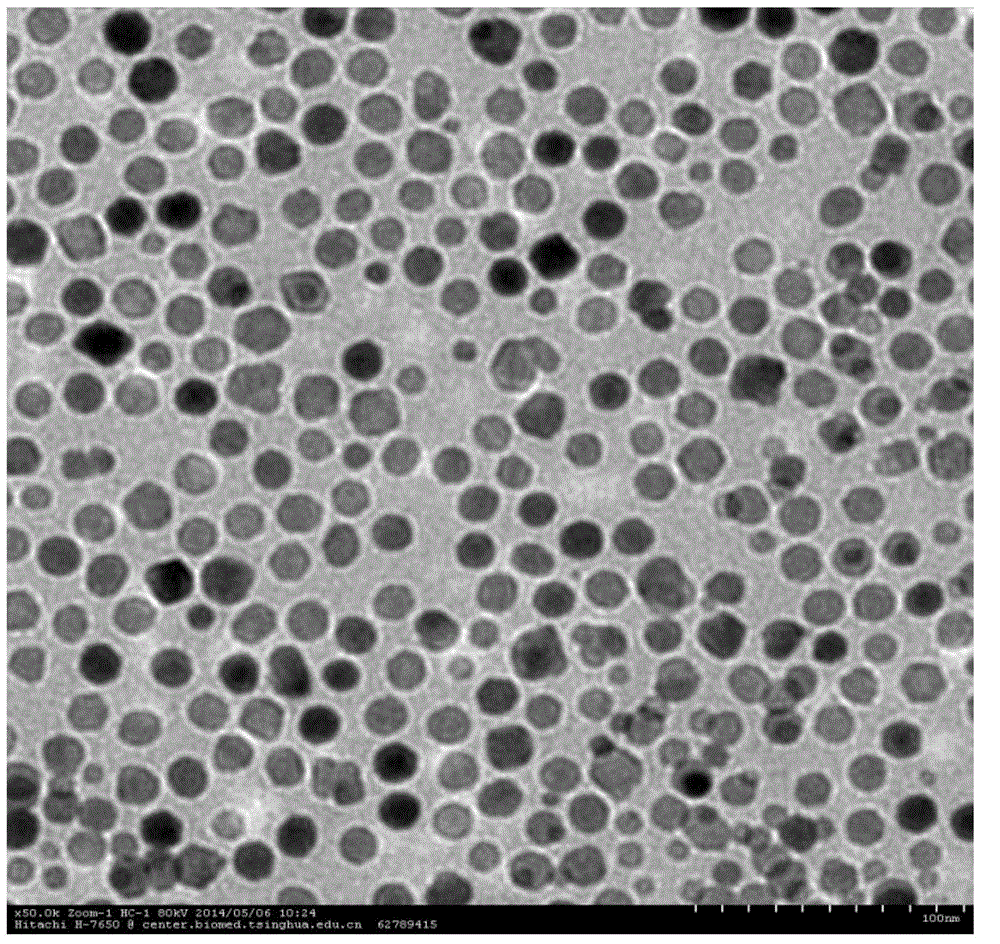Superparamagnetism nanoparticles, preparation method therefor and applications
A superparamagnetic and nanoparticle technology, applied in the nano field, can solve the problems of small saturation magnetization, large particle size of contrast agent, poor water solubility and physiological stability, etc., to increase stability, improve stability, and have superior magnetic response. Effect
- Summary
- Abstract
- Description
- Claims
- Application Information
AI Technical Summary
Problems solved by technology
Method used
Image
Examples
Embodiment 1
[0069] In this embodiment, the superparamagnetic iron oxide nanoparticle contrast agent is prepared by the following method, which specifically includes the following steps:
[0070] (1) Take 3g of ferric chloride and dissolve it in a mixed solvent of 40mL of distilled water and 40mL of ethanol to form solution a (concentration of solution a is 37.5mg / mL);
[0071] (2) Weigh 17g of sodium oleate and disperse it in 80mL of n-hexane to form solution b (that is, the mass fraction of oleate is 23.5wt%);
[0072] (3) After mixing solutions a and b, heat to 60°C, stir and reflux for 4h. After washing with water, dry in vacuum to obtain solid d;
[0073] (4) Dissolve 1 g of solid d in 20 mL of octadecene, add 0.5 mL of oleic acid, stir and heat to 300 °C under nitrogen atmosphere, and keep for 1 h to obtain solution e, cool to room temperature, add 41 mL of ethanol for flocculation, and magnetically separate 3 After three times, 10 mg of the precipitate was dispersed in 5 mL of dic...
Embodiment 1
[0078]Characterize the relaxation rate of the superparamagnetic iron oxide nanoparticle contrast agent prepared in Example 1 (Congo Red-MNPs) and Comparative Example 1 (MNPs), the method is as follows, the sample is prepared into 5 samples with different iron ion concentrations , take 200 μL each in the test tube, use the MQ60 magnetic resonance tester at room temperature, set the Carr-Purcell-Meiboom-Gill pulse sequence to measure the spin-spin relaxation time T of the sample 2 , with iron ion concentration and relaxation rate R 2 (1 / T 2 ) to make a linear regression curve, the calculated slope is the relaxation efficiency.
[0079] The result is as image 3 As shown, the Congo red modified superparamagnetic iron oxide nanoparticle contrast agent (Congo red-MNPs) prepared in Example 1 and the superparamagnetic iron oxide nanoparticle contrast agent (MNPs) not connected to the targeting molecule prepared in Comparative Example 1 ) relaxation rate shows a good linear relatio...
Embodiment 2
[0082] In this embodiment, the superparamagnetic iron oxide nanoparticle contrast agent is prepared by the following method, which specifically includes the following steps:
[0083] (1) Weigh 0.8g ferric oxalate and dissolve it in a mixed solvent of 20mL distilled water and 60mL ethanol to form solution a (concentration of solution a is 10mg / mL);
[0084] (2) Weigh 5.17g of sodium oleate and disperse it in 80mL of n-hexane to form solution b (that is, the mass fraction of oleate is 8.5wt%);
[0085] (3) After mixing solutions a and b, heat to 50°C, stir and reflux for 2h. After washing with water, dry in vacuum to obtain solid d;
[0086] (4) Dissolve 1 g of solid d in 10 mL of octadecene, add 1.0 mL of oleic acid, stir and heat to 280°C under nitrogen atmosphere, keep for 1 h to obtain solution e, cool to room temperature, add 44 mL of ethanol for flocculation, and magnetically separate 3 After three times, 10 mg of precipitate was dispersed in 10 mL of chloroform to obtai...
PUM
| Property | Measurement | Unit |
|---|---|---|
| particle diameter | aaaaa | aaaaa |
| concentration | aaaaa | aaaaa |
| particle diameter | aaaaa | aaaaa |
Abstract
Description
Claims
Application Information
 Login to View More
Login to View More - Generate Ideas
- Intellectual Property
- Life Sciences
- Materials
- Tech Scout
- Unparalleled Data Quality
- Higher Quality Content
- 60% Fewer Hallucinations
Browse by: Latest US Patents, China's latest patents, Technical Efficacy Thesaurus, Application Domain, Technology Topic, Popular Technical Reports.
© 2025 PatSnap. All rights reserved.Legal|Privacy policy|Modern Slavery Act Transparency Statement|Sitemap|About US| Contact US: help@patsnap.com



